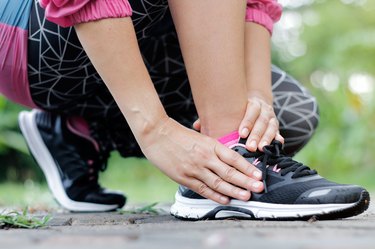
Running offers many health benefits, like improving bone density and strengthening muscles, Cedars Sinai says. Not so fast though — the risk of injury is real, and one common problem you may experience is outer foot pain from running. Sound familiar? Here's why it happens and how you can stop it.
Video of the Day
Video of the Day
Foot Pain After Running
When you think about running injuries, the American Academy of Podiatric Sports Medicine (AAPSM) says that many of the common ones involve the bottom of the feet. This includes injuries such as plantar fasciitis, which presents with pain on the bottom of the foot, as well as heel spurs. The group adds that shin splints, Achilles tendon pain and stress fractures are other common running injuries.
But another place where runners can feel pain is on the outside edge of the foot. Damien Richardson, MD, an orthopedic surgeon with Newport Orthopedic Institute in Newport Beach, California, says a number of different factors can lead to this development.
"The outside portion of the foot is the part of the foot that is the most mobile," Dr. Richardson says. "When running over uneven ground, it is responsible for accommodating and adjusting for impact on these surfaces. This can lead to pain on the outside of the foot. Furthermore, some individuals have a foot posture or shape with a high arch that loads the outside of the foot more than the average person and can lead to pain in these areas."
In some cases, according to the American College of Foot and Ankle Surgeons, these problems may be due to tendonitis or other injuries to the peroneal tendon. The two peroneal tendons extend from the outer ankle bone. One runs under the foot, while the second one attaches to the outer part of the midfoot. This peroneal tendon is a potential source of pain, swelling, weakness or instability on the outside edge of the foot if it becomes injured.
Preventing Runners' Outer Foot Pain
Dr. Richardson says you can make several modifications to your running routine to prevent outer foot pain:
- Choose the right shoes. "Appropriate shoe wear is important to prevent and treat this form of foot pain," Dr. Richardson says. Be sure to spend some time trying different options and finding the right ones for you at a specialty running shoe store.
- Change your running technique. Dr. Richardson adds that high-impact running is another reason for these injuries. You can help by focusing on shorter, quicker strides that have a lower impact.
- Find a softer surface. If unyielding concrete is causing problems, you could try running on a softer surface. "Running on softer, even surfaces such as a well-maintained grass field may help," Dr. Richardson says.
- Look into orthotics. If you're still having problems, you can talk to a podiatrist about the right orthotic options for your running. "If your foot has a flexible, high arch, there are certain orthotics that will help balance and distribute weight across the entire foot," Dr. Richardson says. "These orthotics typically have a recess for the first toe and lateral post at the base of the heel."
Treating Runners' Outer Foot Pain
If lateral foot pain does occur as a result of running, the American College of Foot and Ankle Surgeons says treatment will vary based on its severity.
If it's mild pain, then rest, ice and over-the-counter pain medications can be helpful. More severe circumstances may require foot bracing or physical therapy to help heal the injury. Surgery is typically only required in instances of severe outer foot pain. Be sure to talk to your doctor about the right treatment for your specific circumstances.
- Cedars Sinai: “Ask a Doc: Is Running Good or Bad for You?”
- American Academy of Podiatric Sports Medicine: “Running and Your Feet”
- American College of Foot and Ankle Surgeons: “Peroneal Tendon Injuries”
- Damien Richardson, MD, orthopedic surgeon, Newport Orthopedic Institute, Newport Beach, California
Is this an emergency? If you are experiencing serious medical symptoms, please see the National Library of Medicine’s list of signs you need emergency medical attention or call 911.